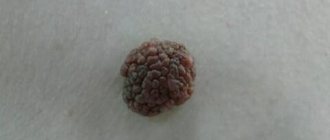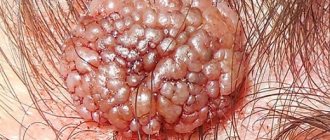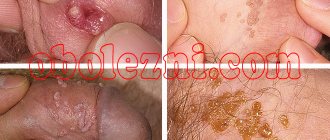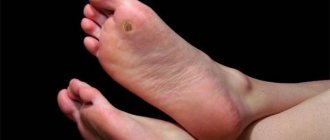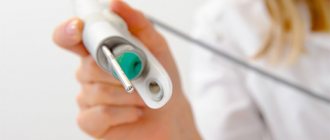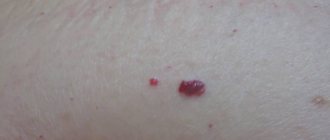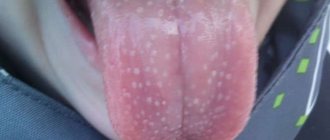General information
Warts are hypertrophied areas of the epithelium, usually resulting from infection with papillomavirus.
They are benign formations on the skin or mucous membrane. They appear more often in children and adolescents who have a weak immune system. Warts can be single or multiple, oval or round, lighter or darker than the surrounding tissue. If left untreated, they can increase in size and cause discomfort.
Neoplasms are localized in different parts of the body:
- face;
- fingers, especially around nails;
- articular surfaces (knees, elbows);
- soles.
Sometimes found on the mucous membrane of the larynx and nose. Such warts often degenerate into cancerous tumors, and therefore require immediate medical attention.
Kinds
There are several variations of papillomas. There are 2 types found on the hands of children:
- Vulgar papillomas are keratinized growths-bumps, the diameter of which can be tiny or reach 1 cm. In children of the white race, they are slightly darker than the skin. The structure of the middle part is somewhat lumpy. They are formed on the hands from the outside and inside, including on the fingers. In a child with a habit of biting off hangnails, simple warts surround the nails. Nearby vulgar papillomas tend to grow together in several pieces. Due to their dense structure, the skin feels tight. Children unconsciously feel and scratch this place.
- Flat formations are colorless, smooth, slightly convex papules. The size does not exceed 3 mm. They are located scattered on the back of the hand. Infants experience itching and irritation of the skin in this area.
Symptoms of warts
Signs of warts in children depend on the type of tumor:
- Ordinary, or vulgar. These are the most common growths that have a stalk. The formations are round, ball-like, rising above the skin. Common warts are characterized by uniform pigmentation, and hair growth is possible in the central part. The formations do not bother the child, do not hurt or itch. Vulgar warts form on the legs, arms, and back.
- Youthful, or flat. This type appears in children over 5 years of age. The formations are clear, irregular in shape, do not rise above the skin and do not have a stalk. They are slightly pigmented, the surface is even and smooth. A distinctive feature of this type of wart is the formation of several growths in one area of the body. They are localized on the face, neck, lower legs, hands and never appear in the armpits or skin folds.
- Pointed, or condylomas. Pink growths consisting of multiple neoplasms of the papillary structure. This type of wart appears on areas with thin skin, genitals, and mucous membranes.
- Acrochords, or filamentous. Long, elongated neoplasms that appear on the face and in the armpits. They do not differ in color from the surrounding tissues and grow quickly. Warts are clearly visible, easily injured and cause discomfort.
- Plantars, or spinules. The growths are located on the foot under the big toe, have a deep root, round shape and resemble calluses. Pathologically changed areas of the dermis hurt when walking. To detect warts in time, parents should regularly examine the child's body while bathing or changing clothes.
Rules for the treatment of warts in young children
Growths in young children can appear on the feet, backs of the hands, face, and fingers. Plantar elements often develop due to impaired blood flow in the feet and increased sweating of the feet. If a virus infection has occurred, the risk of growths appearing on the child’s hands increases with injuries or walking without mittens in the cold season.
It is important for parents to know that childhood warts are not a cosmetic defect, but a sign of a problem in the child’s health. Formations on a baby’s body are often symptoms of infection, poor nutrition, and daily routine. If located in an area with an increased risk of injury, it is necessary to remove the element.
You need to take the appearance of warts seriously. It is better to immediately contact a dermatologist, who will determine the cause of the appearance and select a removal method. The specialist will find out the presence of contraindications and find the best option for painless, effective removal of papillomas.
It is possible to use pharmaceutical drugs: oxolinic, syntomycin ointment. It is better not to use celandine in its pure form and medicines based on it to remove growths in children.
Causes of warts
The main cause of warts in children is the papilloma virus.
Children and adolescents become infected with this pathogen through contact through household items, personal hygiene items, clothing and underwear. Infection occurs in public places, in transport, on playgrounds. It is possible to transmit microorganisms from mother to child during pregnancy. Once on the skin, the virus enters the body through microcracks and wounds. The disease may not manifest itself in any way for a long time. The activation of microorganisms and the appearance of growths occurs under the influence of a number of factors:
- weakened immunity;
- hormonal changes during adolescence;
- unbalanced diet;
- avitaminosis;
- sedentary lifestyle;
- lack of personal hygiene;
- stress, chronic fatigue;
- wearing uncomfortable shoes (relevant for plantar warts).
Important! Neoplasms appear mainly in weakened children with weak immune systems.
Why do warts appear on a child's palm?
The only reason why warts can appear on the palm of a child is damage to the body by the human papilloma virus. This is a pathogen that has many strains. Some of them are quite dangerous, as they can provoke the development of cancer. However, there are few such types of virus. As a rule, they do not cause warts on the child's palm, but affect the reproductive system.
Getting infected with HPV is quite simple: it is enough to come into physical contact with an infected person: shake his hand, kiss him, hug him. The virus is also transmitted through the use of other people's personal hygiene items, dishes, toys, and touching various surfaces. Outside the human body, the virus does not live long and is best preserved in a humid environment. Therefore, potentially dangerous from the point of view of HPV infection are common areas with humid air - saunas, swimming pools, locker rooms, gyms.
It is worth remembering that just the fact of infection with papillomavirus is not enough for warts to appear on the palm of a child. The incubation period for HPV can range from several weeks to several years.
There are certain reasons that cause the virus to become active:
- Deterioration of the child’s immune system, in addition to the activation of HPV, other infections may appear, as well as chronic diseases against the background of a weakening of the body’s protective functions;
- The presence of chronic diseases in the patient's medical history;
- Improper lifestyle - poor nutrition, reduced physical activity, disrupted daily routine;
- Frequent hypothermia or overheating;
- Increased sweating of hands;
- Failure to comply with personal hygiene rules;
- Hormonal fluctuations during adolescence.
There is also a risk of self-infection with HPV. In this case, if there are warts on one part of the body, for example, on the hand, the virus can spread to other parts of the body.
The virus penetrates most easily through microtraumas of the skin: it penetrates into the layers of the dermis and begins to change the DNA structure of cells. As a result of this effect, pathological growths begin to appear on the surface of the epidermis.
Treatment of warts
The decision on how to get rid of a wart in a child should be made by a doctor.
Independent removal of pathologically overgrown areas is dangerous due to the spread of infection to uninfected areas of the skin. Currently, wart removal is possible in various ways:
- Surgical. The wart is excised with a scalpel under local anesthesia. The resulting wound heals in 1-2 weeks, but after removal a scar often remains. This method is not recommended for small children.
- Electrocoagulation. Neoplasm cells are destroyed under the influence of electric current. The manipulation is performed under local anesthesia. After cauterization, the wound is treated with an antiseptic. After 2-3 days, a crust forms at the site of the wart. It disappears after 5-7 days, a scar is formed in rare cases. Electrocoagulation is not suitable for spine removal.
- Cryodestruction. The method involves cauterization with liquid nitrogen. To remove the tumor, 2-4 procedures will be required. After treatment with nitrogen, a blister forms, then a crust, which falls off over time. The method is suitable for older children.
- Laser. This method of wart removal is painless, does not cause complications and does not leave scars. The laser has an antiseptic effect, eliminating infection of the wound. The procedure takes place under local anesthesia and takes a few minutes.
Before removing a wart from a child, the doctor prescribes medications to strengthen the immune system and reduce viral activity. The virus cannot be completely destroyed: it remains in the body for life.
Radical measures
In practical medicine today, the following methods of surgical removal of warts :
- Removal with liquid nitrogen (cryodestruction).
- Laser removal (as the most painless and fastest option, most suitable for children).
- Electrocoagulation or cauterization of papilloma with electric current.
You will find recommendations for the treatment of balanoposthitis in boys on our website.
Prevention of warts
Preventive measures are aimed at strengthening the immune system:
- taking vitamin complexes;
- good nutrition;
- physical activity;
- walks in the open air;
- limited stay in public places (if possible).
The answer to the question of how to remove warts from children in the least traumatic and effective way will be answered by the doctors of the SM-Doctor clinic. A dermatologist will quickly and objectively make a diagnosis and prescribe treatment. Remember that removing tumors on your own is dangerous for the child’s health.
Recourse
If a neoplasm is detected on a child’s body, you must immediately contact a specialist to determine the correct diagnosis and prescribe treatment. Many warts resemble nevi or a certain type of lichen. Therefore, self-medication is strictly contraindicated.
Only a doctor can tell you what treatment is necessary and recommend the appropriate medications. In addition, some types of warts disappear on their own as the child grows older. When the lesion is localized in a visible place, such as the face, immediate professional help is required.
We use cosmetological methods
When treating a wart on a finger with medications , you should not expect a quick effect. Removal lasts on average 2–3 weeks . The same cannot be said about cosmetic procedures. With their help, you can get rid of the tumor immediately.
What procedures can a cosmetologist recommend:
- freezing with liquid nitrogen;
Application of liquid nitrogen.
- electrocoagulation;
- laser therapy;
One of the most common methods for removing warts from a finger.
- cauterization by radio waves.
All these procedures are quite quick, taking no more than 10 minutes. They are done without pain relief. After the procedures, a pimple (dropsy) may appear at the site of the growth; it must not be injured, otherwise infection will occur and a scar or scar will remain.




